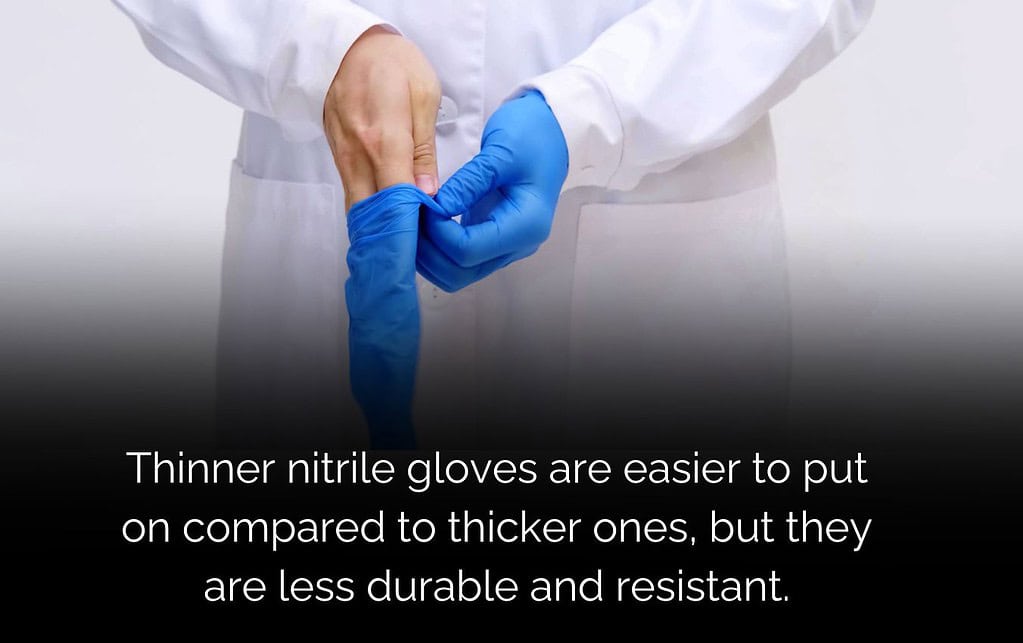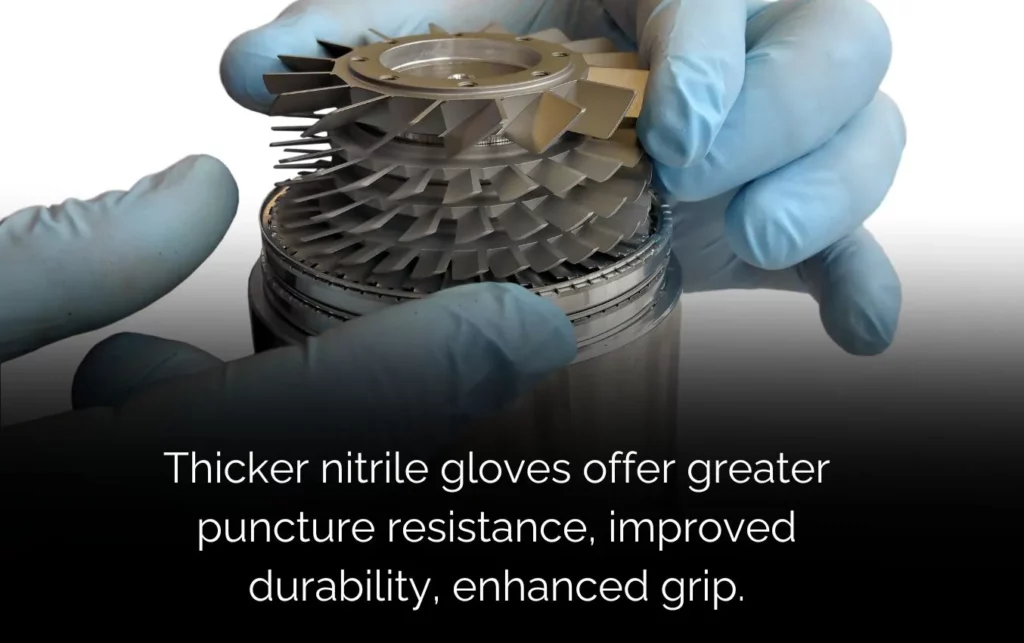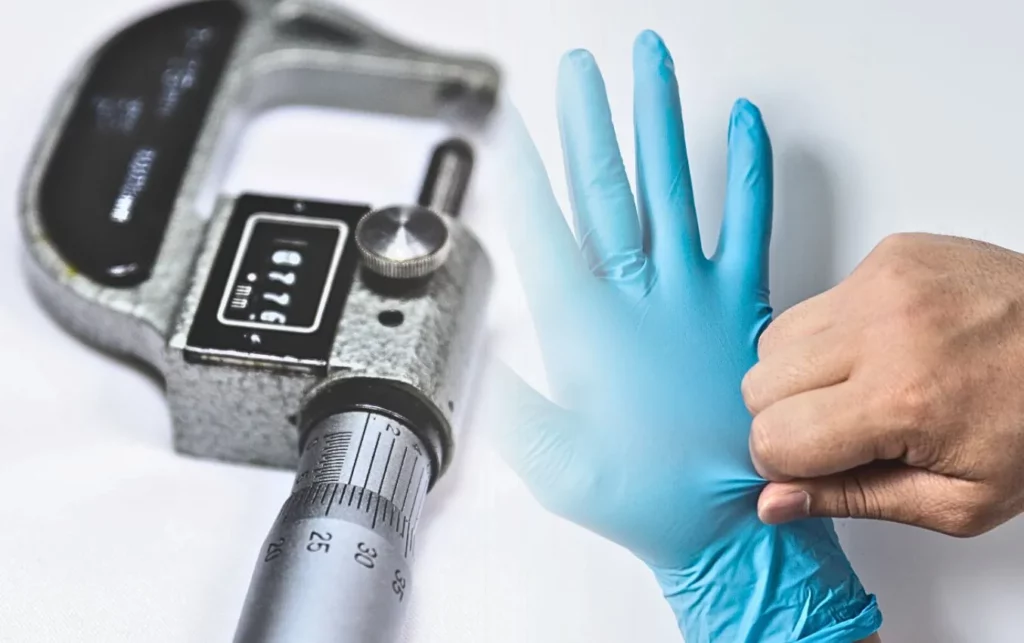- The best thickness for nitrile gloves depends on the specific task and requirements.
- Thinner gloves offer greater tactile sensitivity and flexibility, making them suitable for tasks that require precision and dexterity.
- Thicker gloves provide more durability, protection, and resistance against punctures and chemicals, making them ideal for heavy-duty and high-risk tasks.
- The mil thickness of nitrile gloves ranges from 4 to 15 mils, with thinner gloves being around 4–6 mils and thicker gloves being 8 mils and above.
- Select glove thickness based on industry and use case, such as healthcare, automotive work, or food service.
- It is important to consider factors like comfort, sensitivity, puncture resistance, and chemical resistance when determining the best thickness for nitrile gloves.
When selecting disposable gloves, it is essential to take into account the thickness. The thickness of nitrile gloves affects their performance for various tasks, including the kinds of jobs they can handle. Thinner gloves offer more sensitivity and flexibility, while thicker ones provide durability and protection. To choose the right nitrile glove thickness, consider important factors. Balancing these factors is crucial.
Table of Contents
- Understanding Nitrile Glove Thickness
- The Significance of Thickness in Protective Gloves
- Measuring Glove Thickness: Mils Explained
- 8 MIL, 6 MIL, 5 MIL, 4 MIL
- Comparing Thin vs. Thick Nitrile Gloves
- Benefits of Thin Nitrile Gloves
- Benefits of Thicker Nitrile Gloves
- Industry-Specific Recommendations for Nitrile Glove Thickness
- Healthcare and Medical Use
- Automotive Work and Mechanics
- Food Service and Preparation
- Semiconductors
- How Thickness Affects Glove Performance
- Sensitivity and Dexterity
- Comfort
- Puncture resistance
- Chemical resistance
- Cost considerations when determining the thickness of nitrile gloves
- Tips for Finding the Perfect Balance
- what is the best thickness for nitrile gloves
- Frequently Asked Questions
- What thickness of nitrile gloves is best for medical procedures?
- Can thick nitrile gloves offer better chemical resistance?
- Related Posts
Nitrile gloves, popular in healthcare, automotive, and food industries, offer excellent chemical resistance, strength, and comfort. Thickness varies from 4 to 15 mils. Understanding thickness importance is crucial for protection and functionality across industries.
Understanding Nitrile Glove Thickness
To understand the importance of nitrile glove thickness, it’s essential to know that mil is short for thousandth of an inch and is commonly used to measure glove thickness. A mil is equal to 0.001 of an inch or 0.0254 millimeters and determines the amount of material used in making the glove. Nitrile glove thickness can also be measured in gauge, with 1 gauge being equal to 1 mil. This measurement is important in determining the level of protection and dexterity a glove can provide.
The glove thickness is measured in mils, indicating the distance between the outer and inner surfaces of the material. Thicker gloves have a higher mil thickness, indicating that more material is used in their construction. This results in increased durability and resistance to punctures and chemicals.
On the other hand, thinner gloves have a lower mil thickness, which means they have less material and are more lightweight and flexible. Thinner gloves offer greater tactile sensitivity, allowing the wearer to feel and manipulate objects with precision. However, they may provide less protection against harsh chemicals and punctures.
It is important to note that the mil thickness of a glove may not be uniform throughout its entire structure. For example, the fingertips of a nitrile glove are usually thicker than the wrist area. Manufacturers typically rate glove thickness based on the amount of material at the fingers and palm, while also considering the rigidity of the material throughout the rest of the glove. Understanding the thickness of a nitrile glove is crucial in selecting the best option for your needs.
The Significance of Thickness in Protective Gloves
The thickness of protective gloves, including nitrile gloves, plays a crucial role in determining their level of performance and protection. Thicker gloves are generally more durable and provide stronger protection against punctures, chemicals, and other hazards.
In industries where workers deal with chemicals, thick gloves are suggested. These gloves offer great chemical resistance and provide extra protection. Thick gloves are harder to puncture and work well for tasks with sharp objects. For very harsh substances like hydrofluoric acid, it’s important to use gloves of 8-mil thickness or more for splash protection.
It’s crucial to find the right balance between thickness and dexterity when selecting nitrile gloves for your PPE needs. Thicker gloves can provide more protection against punctures, but they may also reduce sensitivity, making it challenging to perform intricate tasks. When deciding on the best thickness for your protective gloves, it’s important to consider the specific requirements of the task at hand.
The best thickness for nitrile gloves depends on the task. Thicker gloves offer more protection, while thinner ones provide better dexterity. Thinner gloves are best for tasks that need sensitivity, like medical procedures or assembly work. Consider both protection and functionality when choosing glove thickness.
Measuring Glove Thickness: Mils Explained
Measuring glove thickness is an essential step in determining the level of protection and functionality offered by a particular glove. As mentioned earlier, glove thickness is typically measured in mils, which represents the distance between the outer surface and the inner surface of the glove material.
Glove manufacturers use different thickness ratings to indicate the mil thickness of their products. These ratings help users identify the appropriate glove thickness for their specific needs. Thinner gloves usually have lower mil ratings, while thicker gloves have higher mil ratings.
For example, a 4 mil nitrile glove has a thickness of 0.004 inches, while an 8 mil nitrile glove has a thickness of 0.008 inches. The mil rating provides a quick reference point for understanding the relative thickness of different gloves.
It is important to note that the mil thickness is not the sole determinant of a glove’s performance. Other factors, such as the quality of the material and manufacturing process, also contribute to a glove’s overall effectiveness. Therefore, it is advisable to consider the mil thickness along with other factors when selecting the right glove for a specific task or industry.
8 MIL, 6 MIL, 5 MIL, 4 MIL
When it comes to nitrile gloves, there are various mil thickness options available, ranging from 4 mils to 8 mils. Each mil thickness offers different levels of protection and functionality, making it important to choose the right thickness for the task at hand.
Here’s a breakdown of the different mil thickness options for nitrile gloves:
| Mil Thickness | Applications |
|---|---|
| 4 mils (Thin and lightweight) | Suitable for tasks that require high dexterity and sensitivity, such as medical procedures, salon and laboratory work |
| 5 mils (Medium thickness) | Provides a balance between flexibility and protection, ideal for general-purpose use in industries like food service, general cleaning and janitorial services. |
| 6 mils (Thicker and more durable) | Offers increased puncture resistance and chemical resistance, suitable for heavy-duty tasks in automotive work and industrial settings |
| 8 mils and above (Extra thick and rugged) | Provides maximum protection against punctures, chemicals, and hazardous materials, commonly used in specialized tasks like hazardous waste cleanup and heavy machinery operation. |
It is important to consider the specific requirements of the task, as well as the wearer’s comfort and dexterity, when choosing the mil thickness of nitrile gloves. Thicker gloves, such as those with 8, 6, or 5 mils of thickness, offer more robust protection, but may sacrifice some level of flexibility and tactile sensitivity. Thinner gloves, such as those with 4 mils of thickness, provide greater dexterity and sensitivity but may offer less resistance to punctures and chemicals.
Comparing Thin vs. Thick Nitrile Gloves
When deciding between thin and thick nitrile gloves, it is important to consider the trade-off between tactile sensitivity and durability. Thin gloves offer greater tactile sensitivity, allowing the wearer to feel and manipulate objects with precision. They are ideal for tasks that require intricate movements and dexterity.
On the other hand, thick nitrile gloves provide increased durability and protection. They are more resistant to punctures and chemicals, making them suitable for heavy-duty tasks and environments where hazards are present.
Ultimately, the choice between thin and thick nitrile gloves depends on the specific requirements of the task and the level of protection needed.

Benefits of Thin Nitrile Gloves
Thin nitrile gloves offer several benefits, especially in applications where tactile sensitivity is crucial. Here are some advantages of using thin nitrile gloves:
- Enhanced tactile sensitivity: Thin gloves allow users to feel and manipulate objects with precision, making them ideal for tasks that require fine motor skills.
- Greater dexterity: The flexibility of thin nitrile gloves enables users to perform intricate tasks with ease.
- Comfortable fit: Thin gloves provide a snug fit, offering comfort and reducing hand fatigue during extended use.
- Suitable for frequent glove changes: Thin gloves are cost-effective for tasks that require frequent glove changes, such as food service and beauty applications.
- Appropriate applications: Thin nitrile gloves are commonly used in industries like healthcare, food service, and beauty where tactile sensitivity and dexterity are essential.

Benefits of Thicker Nitrile Gloves
Thicker nitrile gloves offer increased durability and protection, making them suitable for tasks that involve handling hazardous materials. Here are some benefits of using thicker nitrile gloves:
- Enhanced chemical resistance: Thicker gloves provide better protection against chemicals and hazardous substances, reducing the risk of exposure and contamination.
- Greater puncture resistance: Thicker nitrile gloves are less prone to punctures, providing added protection when working with sharp objects or rough surfaces.
- Improved durability: Thicker gloves are designed to withstand more rigorous use, making them suitable for heavy-duty tasks that require prolonged wear.
- Enhanced grip: The thickness of nitrile gloves can improve grip, allowing users to hold onto objects securely, even in wet or oily conditions.
- Recommended for specific industries: Thicker nitrile gloves are commonly used in industries such as automotive work, laboratories, and construction, where greater protection is required.
Industry-Specific Recommendations for Nitrile Glove Thickness
When it comes to choosing the right thickness of nitrile gloves, different industries have specific recommendations based on their unique requirements. Here are some industry-specific recommendations for nitrile glove thickness:
Healthcare and Medical Use
In healthcare and medical settings, the choice of nitrile glove thickness is crucial to ensure the safety of both the healthcare professional and the patient. Here are some considerations for nitrile glove thickness in healthcare and medical use:
- Medical grade gloves: Healthcare professionals require gloves that meet specific quality standards to provide adequate protection. Exam grade gloves, which are typically 4-5 mils thick, are commonly used in medical settings.
- Chemical resistance: In certain medical procedures, such as chemotherapy administration, thicker nitrile gloves with a thickness of 6 to 8 mils are recommended to provide additional chemical resistance.
- Disposable nitrile gloves: Disposable gloves are preferred in healthcare settings due to their convenience and hygiene. Nitrile gloves are a popular choice as they offer superior strength, flexibility, and chemical resistance compared to latex gloves.
Automotive Work and Mechanics
In automotive work and mechanics, strong protection with the right nitrile glove thickness is essential as it is a top priority to protect against hazards and ensure optimal performance. Here are some considerations for nitrile glove thickness in automotive work:
- Durability: Automotive work involves handling sharp tools, heavy machinery, and exposure to oil and grease. Thick nitrile gloves, with a thickness of 6 to 8 mils, provide the necessary durability and puncture resistance.
- Puncture resistance: Thicker nitrile gloves offer better puncture resistance, protecting mechanics from potential injuries caused by sharp objects or rough surfaces.
- Oil and grease resistance: Nitrile gloves are resistant to oil and grease, making them suitable for automotive work where these substances are commonly encountered.
Food Service and Preparation
In the food service industry, glove thickness plays a critical role in maintaining food safety and preventing contamination. Here are some considerations for nitrile glove thickness in food service and preparation:
- Contamination prevention: Thin nitrile gloves, with a thickness of 2 to 3 mils, are commonly used in food service settings to ensure dexterity and tactile sensitivity while preventing contamination.
- Frequent glove changes: Food service tasks often require frequent glove changes to maintain hygiene. Thin gloves are more cost-effective for such applications.
- Food safety regulations: Food establishments must comply with strict regulations regarding glove usage to prevent cross-contamination. Thin nitrile gloves provide the necessary protection without compromising dexterity.
Semiconductors
In semiconductor manufacturing, precision and contamination control are paramount. Here are some considerations for nitrile glove thickness in semiconductor industry:
- Cleanroom requirements: Semiconductor manufacturing facilities maintain cleanroom environments to prevent contamination. Thicker nitrile gloves, with a thickness of 6 to 8 mils, are recommended to provide puncture resistance and protect against potential hazards.
- Chemical resistance: Thicker gloves offer better resistance against chemicals used in semiconductor processes, providing an additional layer of protection for workers.
- Puncture resistance: Thicker nitrile gloves are less prone to punctures, ensuring that sharp objects commonly found in semiconductor manufacturing do not penetrate the gloves.
How Thickness Affects Glove Performance
The thickness of nitrile gloves can significantly impact their performance in various tasks. Here’s how different aspects of glove performance are affected by thickness:
- Sensitivity and Dexterity: Thinner nitrile gloves offer better tactile sensitivity and dexterity, allowing users to perform delicate tasks with precision. However, thicker gloves may reduce sensitivity and dexterity due to their increased material thickness.
- Comfort: The thickness of a glove can affect the level of comfort it provides. Thinner gloves often offer a better fit and feel more comfortable, especially during extended wear.
- Puncture resistance: Thicker nitrile gloves, with a higher mil thickness, provide better puncture resistance, reducing the risk of injuries when handling sharp objects or working in hazardous environments.
- Chemical resistance: Thicker gloves offer improved chemical resistance, protecting the wearer from potential exposure to harsh chemicals and hazardous substances.
It’s important to strike the right balance between thickness and functionality based on the specific requirements of the task at hand.
Sensitivity and Dexterity
The thickness of nitrile gloves directly affects their tactile sensitivity and dexterity. Here’s how thinner gloves can enhance these qualities:
- Tactile sensitivity: Thinner gloves allow users to feel and manipulate objects more accurately, making them suitable for tasks that require precise control and touch.
- Dexterity: Thinner gloves offer better finger flexibility and range of motion, enabling users to perform delicate tasks with ease and precision.
However, it’s important to strike a balance between thickness and protection. While thinner gloves provide enhanced sensitivity and dexterity, they may offer less protection against punctures and chemicals compared to thicker gloves with higher mil thickness.
Comfort
The thickness of nitrile gloves can impact comfort during use. Here are some factors to consider regarding glove thickness and comfort:
- Correct size: Ensuring the correct size of nitrile gloves is essential for comfort. Ill-fitting gloves, regardless of thickness, can cause discomfort and hinder dexterity.
- Fit and feel: Thinner gloves often provide a better fit and feel, offering a more natural sensation on the hand. This can contribute to increased comfort during extended wear.
- Disposable glove considerations: Disposable gloves are designed for single-use applications, so comfort is important to minimize discomfort and fatigue during tasks that require prolonged glove use.
While thinner gloves may offer enhanced comfort, it’s crucial to strike a balance between comfort and the level of protection required for the specific task.
Puncture resistance
Puncture resistance is a key consideration when choosing the thickness of nitrile gloves. Here’s how thicker gloves can provide better protection against punctures:
- Thick nitrile gloves, with a higher mil thickness, offer improved puncture resistance compared to thinner gloves. This makes them suitable for tasks that involve handling sharp objects, rough surfaces, or materials with potential puncture hazards.
- The increased material thickness in thick nitrile gloves provides an additional barrier against punctures, reducing the risk of injuries and contamination.
- It’s important to select gloves with the appropriate mil thickness based on the specific task requirements and potential puncture hazards involved.
Chemical resistance
Chemical resistance is a critical factor to consider when selecting nitrile gloves, and the thickness of the gloves plays a role in providing adequate protection. Here’s how thicker gloves offer better chemical resistance:
- Thicker nitrile gloves, with a higher mil thickness, provide an increased barrier against chemicals and hazardous substances.
- The additional material thickness in thicker gloves enhances their resistance to permeation, reducing the risk of chemical exposure and potential skin irritation.
- Thicker gloves are recommended for tasks that involve handling harsh chemicals or working in environments where chemical contact is likely.
- It’s essential to select gloves with the appropriate mil thickness based on the specific chemical hazards and exposure risks involved in the task.
Cost considerations when determining the thickness of nitrile gloves
When choosing the thickness of nitrile gloves, cost considerations are important. Here’s why:
- Material usage: Thicker gloves require more material to manufacture, resulting in higher production costs. Thinner gloves, on the other hand, are more cost-effective due to their lower material requirements.
- Disposable nitrile gloves: Nitrile gloves are primarily used as disposable gloves, and their cost-effectiveness is an essential factor to consider. Thinner gloves may be a more economical option for tasks that require frequent glove changes.
- Acceptable quality limit (AQL): The AQL is a standard that defines the acceptable percentage of defective gloves in a batch. Balancing cost and quality is essential to ensure that the gloves meet the required standards while remaining cost-effective.
- It’s important to consider both the cost and the quality requirements when determining the appropriate thickness of nitrile gloves for a particular task.
Tips for Finding the Perfect Balance
Finding the perfect balance in nitrile glove thickness involves considering various factors and use cases. Here are some tips to help you make the right choice:
- Identify the use case: Understand the specific requirements of the task or industry where the gloves will be used. Consider factors such as protection level, dexterity, and chemical resistance.
- Evaluate the mil thickness: Assess the mil thickness options available and select one that strikes the right balance between protection and functionality. Thinner gloves offer better tactile sensitivity, while thicker gloves provide enhanced durability and resistance.
- Consider industry recommendations: Different industries may have specific guidelines for glove thickness based on their unique requirements. Consider industry-specific recommendations to ensure the gloves meet the necessary standards.
- Test different options: Try out gloves with different thicknesses to determine which ones are most comfortable and suitable for the task at hand. Proper fit and comfort are essential for optimal performance.
- Consult with suppliers: Reach out to glove suppliers or experts in the field for guidance on selecting the right glove thickness for your specific needs. They can provide valuable insights and recommendations based on their expertise.
By following these tips and considering key factors, you can find the perfect balance of glove thickness for your specific application.
what is the best thickness for nitrile gloves
Choosing what is the best thickness for nitrile gloves depends on the intended use and industry-specific requirements. Whether opting for thin or thick nitrile gloves, factors such as sensitivity, comfort, puncture and chemical resistance, and cost considerations play a crucial role. Understanding the significance of glove thickness, whether it’s 8 MIL, 6 MIL, 5 MIL, or 4 MIL, is essential for optimal performance. By finding the perfect balance between thickness and functionality, you can ensure the best protection for your hands in various applications and industries.
Frequently Asked Questions
What thickness of nitrile gloves is best for medical procedures?
The best thickness of nitrile gloves for medical procedures depends on the specific requirements of the procedure. Medical grade gloves, typically 4-5 mils thick, are commonly used in healthcare settings for their balance of protection and tactile sensitivity. The appropriate glove thickness should be determined based on factors such as chemical resistance and the level of protection required.
Can thick nitrile gloves offer better chemical resistance?
Thick nitrile gloves, with a higher mil thickness, generally offer better chemical resistance compared to thinner gloves. The increased material thickness provides an additional barrier against harsh chemicals and hazardous substances, reducing the risk of chemical exposure.

